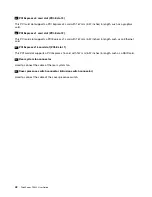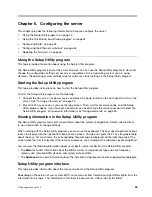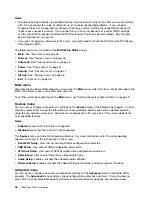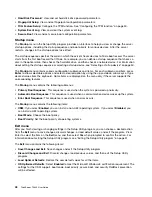
•
RAID 5
: block-level striping with distributed parity
RAID 5 uses disk striping and parity data across all drives (distributed parity) to provide high data
throughput, especially for small random access. RAID 5 distributes parity along with the data and requires
all drives but one to be present to operate; drive failure requires replacement, but the array is not
destroyed by a single drive failure. Upon drive failure, any subsequent read operations can be calculated
from the distributed parity so that the drive failure is masked from the end user. The array will have data
loss in the event of a second drive failure and is vulnerable until the data that was on the failing drive is
rebuilt onto a replacement drive. A single drive failure in the set will result in reduced performance of
the entire set until the failing drive has been replaced and rebuilt.
RAID 5 requires a minimum number of three hard disk drives.
•
RAID 10
: a combination of RAID 0 and RAID 1
RAID 10 consists of striped data across mirrored spans. A RAID 10 drive group is a spanned drive
group that creates a striped set from a series of mirrored drives. RAID 10 allows a maximum of eight
spans. You must use an even number of drives in each RAID virtual drive in the span. The RAID 1
virtual drives must have the same stripe size. RAID 10 provides high data throughput and complete data
redundancy but uses a larger number of spans.
RAID 10 requires a minimum number of four hard disk drives and also requires an even number of drives,
for example, six hard disk drives or eight hard disk drives.
•
RAID 50
: a combination of RAID 0 and RAID 5
RAID 50 uses distributed parity and disk striping. A RAID 50 drive group is a spanned drive group in
which data is striped across multiple RAID 5 drive groups. RAID 50 works best with data that requires
high reliability, high request rates, high data transfers, and medium-to-large capacity.
Note:
Having virtual drives of different RAID levels, such as RAID 0 and RAID 5, in the same drive group is
not allowed. For example, if an existing RAID 5 virtual drive is created out of partial space in an array, the
next virtual drive in the array has to be RAID 5 only.
RAID 50 requires a minimum number of six hard disk drives.
For detailed information about RAID, refer to “Introduction to RAID” in the
MegaRAID SAS Software User
Guide
on the documentation DVD that comes with your server.
RAID for your server
This topic provides information about the RAID supported by your server.
Note:
Before configuring RAID for your server, ensure that you use hard disk drives that are of the same type
(SATA or SAS) and have the same capacity within a single RAID array.
Your server supports the following two types of RAID configurations:
•
Onboard SATA software RAID configuration using the Intel Rapid Storage Technology enterprise
program
The onboard SATA software RAID controller is integrated on the Intel C220 chip on the system board.
If your server has SATA hard disk drives that are connected to the system board, you can use the Intel
Rapid Storage Technology enterprise program to configure RAID. By default, your server supports
onboard SATA software RAID levels 0, 1, 5, and 10.
For detailed information, see “Configuring the system BIOS to enable onboard SATA RAID functionality”
on page 57.
56
ThinkServer TS440 User Guide
Содержание ThinkServer TS440
Страница 1: ...ThinkServer TS440 User Guide Machine Types 70AL 70AM 70AN and 70AQ ...
Страница 16: ...4 ThinkServer TS440 User Guide ...
Страница 18: ...6 ThinkServer TS440 User Guide ...
Страница 56: ...44 ThinkServer TS440 User Guide ...
Страница 74: ...62 ThinkServer TS440 User Guide ...
Страница 166: ...154 ThinkServer TS440 User Guide ...
Страница 176: ...164 ThinkServer TS440 User Guide ...
Страница 181: ......
Страница 182: ......






























